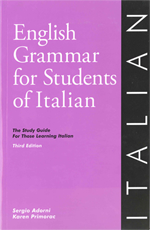Dinner at a Trattoria or Ostaria is less formal and less expensive, while dinner at a Ristorante is a bit more upscale and more pricey.
When ordering food you’ll need to notice differences in masculine and feminine nouns as well as singular and plural nouns. Let’s look at a few you saw in the menus.

 Review pages 7-12 in the printed version of the purple textbook or view pages 28-39 in the digital version online. Nouns based on biological gender have the same gender as the person to whom they refer. All other nouns have a gender unrelated to their meaning but which can often be determined by the ending. Nouns ending in -o are usually masculine and nouns ending in -a and -i are usually feminine. Nouns ending in a consonant are always masculine as they often come from other languages and are assigned masculine gender. Nouns ending in -e can be either masculine or feminine (although -ie, -trice, -ione and -dine are always feminine); their gender should be memorized.
Review pages 7-12 in the printed version of the purple textbook or view pages 28-39 in the digital version online. Nouns based on biological gender have the same gender as the person to whom they refer. All other nouns have a gender unrelated to their meaning but which can often be determined by the ending. Nouns ending in -o are usually masculine and nouns ending in -a and -i are usually feminine. Nouns ending in a consonant are always masculine as they often come from other languages and are assigned masculine gender. Nouns ending in -e can be either masculine or feminine (although -ie, -trice, -ione and -dine are always feminine); their gender should be memorized.
Here's a menu. The items below are examples of masculine and feminine nouns.
| Masculine | |
|---|---|
| antipastoantipasto | panepane |
| primoprimo | secondosecondo |
| contornocontorno | formaggioformaggio |
| caffècaffè | spumantespumante |
| vinovino |
| Feminine | |
|---|---|
| insalatainsalata | fruttafrutta |
| pizzapizza | birrabirra |
| acquaacqua | coca-colacoca-cola |
| mozzarellamozzarella |
